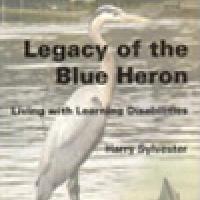Excerpt from “Introduction” of Legacy of the Blue Heron
View more information about Legacy of the Blue Heron(opens in a new window).
I come from a farm background, and when I was growing up spent a lot of time working outdoors and in the fields and just loved it. It also was a place where I could use my own abilities in the mechanical areas. Before I was 10 years old, I was driving trucks and tractors and operating all kinds of farm machinery better than any hired man. I could drive the tractor that hauled the mower, or the hay rake, or the potato digger, depending on the time of year. If I got going too fast and broke something, or if a gear broke or the potato digger got plugged up, I had the ability to fix it. I really looked forward to summers, to be out in the fields and away from school. I remember one spring, the last day of school was a school picnic, and I had the choice of going to the school picnic or driving a tractor all day. I drove the tractor.
One year when I was 11 or 12 years old, we were haying, and it happened one day that my work was all caught up and I was just riding on a tractor with my father while he was raking. We were visiting and enjoying the time. All of a sudden in the field there appeared a blue heron. It was a young one, and it was learning to fly. It kind of bobbed around in the field, and would fly a little bit and then be on the ground, walking around. We watched the performance for a little while, until the blue heron drifted off the field into the edge of some bushes and trees.
I got off the tractor and went exploring to see if I could find it. After a while, I spotted the heron in some brush near a rock pile. I picked up one of the rocks and threw it at the heron, and for some strange reason it hit the heron right in the head. Was I surprised, because one of the things that I can’t do is throw anything! The heron was dead. It happens that in the part of the world that I grew up in, the blue heron was called a sh**-poke, because it pokes around in the mud in the shallows of ponds and streams. So I hadn’t really done anything wrong; what I had done was rid the world of one more sh**-poke.
I started looking the bird over, and the first thing that struck me was, this bird is huge. Not only that, it seemed to be quite clean, and there was no bad smell to it. And it had some very interesting colors. I found the bird to be fascinating, and I carried it back to show my father. He thought I’d done a good job.
I became interested in the blue heron that day and started studying it. I was quite amazed at what I saw. I discovered that blue herons certainly do spend a lot of time in the shallow end of the lake, feeding and what looks like poking around in the mud. However, they’re more apt to be feeding on small fish or frogs. They are huge and quietly go about their business. They are quiet and don’t complain about anything, except once in a while if another blue heron encroaches on their territory, they might squawk about that. These huge birds can land in a tree, fold up their long legs, and roost for the night. They are beautiful, peaceful, and intelligent and have lots to teach us. I feel very bad about the first one I encountered, but have had the opportunity to learn from them for many years.
When herons stand, they are very tall, and their long legs are very evident. This is just like me. They are huge, slow, and go about their business quietly without making lots of fuss. As I got into the learning disabilities field, I could see that the heron had a bad reputation, undeserved, just like me. The blue herons and I have quietly been trying to sneak through life without getting into trouble.
About 15 years ago, I started looking at learning disabilities, or dyslexia, for my own personal reasons. It was difficult to get information or find people who understood the questions that I was asking. However, I did manage to learn that I was not the only one in the world who had these strange language difficulties — in fact, I was very surprised to find that about 10% of the population have similar problems. I also learned that there was understanding and knowledge to help us figure out why our lives — in school, at work, and in our personal relationships — never seemed to work right. Soon I was answering questions that other people had about learning disabilities, and I quickly started using my experience and knowledge to help others. This was not a direction or field I had ever expected to go in; it just happened automatically, and it was a very natural direction to take.
This direction has led me into many different roles, working with many different kinds of people. This book is an attempt to bring all of these experiences together, because they are all related. I hope that my readers will end up with a better understanding of what it means to have a learning disability, and that those with disabilities will find some solutions for their difficulties.
